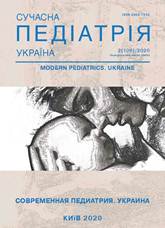Clinical and immunological characteristics of children with primary hypogammaglobulinemiae
Keywords:
primary hypohammaglobulinemia, children, bacterial infections, chronic bronchitis, serum immunoglobulins, subpopulations of lymphocytes, bronchiectasisAbstract
Objective: study of clinical and immunological indicators in children with primary hypogammaglobulinemia in order to determine treatment tactics.
Material and methods. 53 children with primary hypogammaglobulinemiae were examined. Anamnesis and data of immunological examination (levels of serum immunoglobulins IgA, IgM, IgG, subpopulations of lymphocytes) were collected from each child at the time before the beginning of immunoglobulin replacement therapy.
Results. The most common features of primary hypogammaglobulinemia were recurrent bacterial infections, observed in 44 children out of 53 (83%). Autoimmune diseases and allergic diseases were foundwith the same frequency, in 8 children (15.1%). Bronchoectatic disease occurred in 5 children (9.4%). The levels of serum IgG (1.77±2.61 g/l) and IgM (0.062±0.14 g/l), and level of B lymphocytes (0.27±0.22%, 13.7±14.1×109) were the lowest in the group of children with X-linked hypogammaglobulinemia, compared to other groups of children with primary hypogammaglobulinemia.
Conclusions. Therefore, in our study it was found that the most common clinical manifestations in children with primary hypogammaglobulinemia were recurrent bacterial infections, autoimmune and allergic pathology was rare. The development of bronchiectatic disease is associated with the presence of chronic bronchitis and recurrent pneumonia, late diagnosis of antibody deficiency and late beginning of regular immunoglobulin replacement therapy. Early diagnosis and timely correction of antibody deficiency play a key role in the prevention of the development of of bacterial infections and their complications.
The research was carried out in accordance with the principles of the Helsinki Declaration. The study protocol was approved by the Local Ethics Committee of an participating institution. The informed consent of the patient was obtained for conducting the studies.
References
Volokha AP. (2009). Features of the course of primary antibody deficiencies in children, determination of early criteria of diagnostics and rationale of differentiated approaches to treatment. Dissertation. Kyiv: Ministry of Health of Ukraine, National O. O. Bohomolets Medical University:
Alkan G, Keles S and Reisli E. (2018, April 23). Evaluation of Clinical and Immunological Characteristics of Children with Common Variable Immunodeficiency. International Journal of Pediatrics. Article ID 3527480: 1–8. https://doi.org/10.1155/2018/3527480; PMid:29849668 PMCid:PMC5937368
Azizi G, Ahmadi M, Abolhassani H, Yazdani R et al. (2016). Autoimmunity in Primary Antibody Deficiencies. Int Arch Allergy Immunol.171(3–4): 180–193. https://doi.org/10.1159/000453263; PMid:28013299
Azizi G, Bagheri Y, Tavakol M, Askarimoghaddam F et al. (2018). The Clinical and Immunological Features of Patients with Primary Antibody Deficiencies. Endocr Metab Immune Disord Drug Targets.18(5): 537–545. https://doi.org/10.2174/1871530318666180413110216; PMid:29651973
Bazregari S, Azizi G, Tavakol M, Asgardoon MH et al. (2017, Dec 30). Evaluation of infectious and non8infectious complications in patients with primary Immunodeficiency. Central European Journal of Immunology. 42(4): 336–341. https://doi.org/10.5114/ceji.2017.72825; PMid:29479289 PMCid:PMC5820987
Bonagura V, Kaplan B, Jongco A. (2016). Management of primary antibody deficiency syndromes. Ann Allergy Asthma Immunol.117: 620–626. https://doi.org/10.1016/j.anai.2016.08.016; PMid:27979019
Brignier AC, Mahlaoui N, Reimann C, Picard C et al. (2015, Oct). Early-onset hypogammaglobulinemia: A survey of 44 patients. J Allergy Clin Immunol. 136(4): 1097–1099. https://doi.org/10.1016/j.jaci.2015.03.038; PMid:25959671
Carvalho PD, Costa C, Rodrigues M, Salvador MJ et al. (2016, Jan-Mar). Dermatomyositis-like syndrome in X-linked agammaglobulinemia. Acta Reumatol Port. 41(1): 78–81.
Dorna MB, Santos CJ, Castro AP, Oliveira LA et al. (2016, Sep). Primary hypogammaglobulinemia: The impact of early diagnosis in lung complications. Scielo. 62(6): 530–536. https://doi.org/10.1590/1806-9282.62.06.530; PMid:27849230
Fried AJ, Bonilla FA. (2009, July). Pathogenesis, Diagnosis, and Management of Primary Antibody Deficiencies and Infections. Clinical microbiology reviews. 22(3): 396–414. https://doi.org/10.1128/CMR.00001-09; PMid:19597006 PMCid:PMC2708392
Janssen LMA, Bassett P, Macken T, van Esch J et al. (2018, Oct 15). Mild Hypogammaglobulinemia Can Be a Serious Condition. Frontiers in immunology. Original Research. 9 (article 2384): 1–8. https://doi.org/10.3389/fimmu.2018.02384; PMid:30374358 PMCid:PMC6196282
Kidon MI, Handzel ZT, Schwartz R, Altboum I et al. (2004, Oct 21). Symptomatic hypogammaglobulinemia in infancy and childhood – clinical outcome and in vitro immune responses. BMC Family Practice.5(23): 1–7. https://doi.org/10.1186/1471-2296-5-23; PMid:15498106 PMCid:PMC529469
Liu X1, Zhou K, Yu D, Cai X et al. (2017, Dec). A delayed diagnosis of X-linked hyper IgM syndrome complicated with toxoplasmic encephalitis in a child. Medicine (Baltimore).96(49): 1–6. https://doi.org/10.1097/MD.0000000000008989; PMid:29245273 PMCid:PMC5728888
Lopez-Rocha E, O'Farril-Romanillos P, Cerda-Reyes S, Medina-Torres EA et al. (2017, Apr-Jun). Angioedema as initial manifestation of hypogammaglobulinemia.64(2): 228–234. https://doi.org/10.29262/ram.v64i2.187; PMid:28658731
Membrila-Mondragon J, Staines-Boone AT, Sanchez-Sanchez LM, Ruiz-Pedraza MD. (2015). Pulmonary complications in pediatric patients with primary immnodefficiency. Gaceta Medica De Mexico.151: 145–151.
Modell V, Knaus M, Modell F, Roifman C et al. (2014, Oct). Global overview of primary immunodeficiencies: a report from Jeffrey Modell Centers worldwide focused on diagnosis, treatment, and discovery. Immunol Res. 60(1): 132–44. https://doi.org/10.1007/s12026-014-8498-z; PMid:24668296
Tan Q, Ren FL, Wang H. (2017, Aug). Pyoderma Gangrenosum in a Patient with X-Linked Agammaglobulinemia. Ann Dermatol.29(4): 476–478. https://doi.org/10.5021/ad.2017.29.4.476; PMid:28761297 PMCid:PMC5500714
Tarzi MD, Grigoriadou S, Carr SB, Kuitert LM et al. (2009, Feb). Clinical Immunology Review Series: An approach to the management of pulmonary disease in primary antibody deficiency. Clin Exp Immunology.155(2): 147–155. https://doi.org/10.1111/j.1365-2249.2008.03851.x; PMid:19128358 PMCid:PMC2675244
Tavakol M, Kouhi A, Abolhassani H, Ghajar A et al. (2014 Jun). Otological Findings in Pediatric Patients with Hypogammaglobulinemia. Iran J Allergy Asthma Immunol. 13(3): 166–173.
Downloads
Published
Issue
Section
License
The policy of the Journal “MODERN PEDIATRICS. UKRAINE” is compatible with the vast majority of funders' of open access and self-archiving policies. The journal provides immediate open access route being convinced that everyone – not only scientists - can benefit from research results, and publishes articles exclusively under open access distribution, with a Creative Commons Attribution-Noncommercial 4.0 international license (СС BY-NC).
Authors transfer the copyright to the Journal “MODERN PEDIATRICS. UKRAINE” when the manuscript is accepted for publication. Authors declare that this manuscript has not been published nor is under simultaneous consideration for publication elsewhere. After publication, the articles become freely available on-line to the public.
Readers have the right to use, distribute, and reproduce articles in any medium, provided the articles and the journal are properly cited.
The use of published materials for commercial purposes is strongly prohibited.

